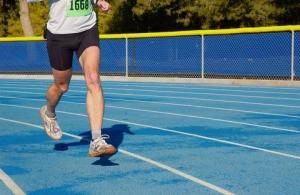Runner’s Knee: An Overview
Iliotibial Band Syndrome: Treatment Options
As we continue our topic on Iliotibial Band Syndrome, this article includes an additional stretching technique. Several other supplementary treatment options will also be discussed .
Simple stretching exercise
- Stand in front of a wall with feet together.
- Extend one arm and place a hand on the wall.
- Slowly and carefully stretch the hips toward the wall and hold the position for a few seconds.
- Return to a standing position.
- Turn around and place the other hand on the wall and repeat the process.
This stretching exercise can help regain the suppleness of the iliotibial band and is effective if done regularly.
If a patient does these stretches regularly and find they are not getting any relief, there are other ways to relieve iliotibial band syndrome. Using a foam roller will help to stretch out and relieve the tightened iliotibial band. Place the foam roller on the floor and roll the affected area on top of it back and forth.
Additional Treatment Options
Should these techniques still not improve the condition, this could indicate that the patient has extremely tight connective tissue. Incorporating chiropractic manipulation as part of the rehabilitation process can benefit the patient hugely. A full evaluation by a chiropractor is important in treating iliotibial band syndrome. A patient’s muscle balance must also be assessed in order to better identify all the contributing symptomatic factors. This includes a full biomechanical examination too.
The chiropractor may recommend the patient to rest and take time off all activities that could aggravate their symptoms, including any sporting activities. Further recommendations may require the patient to ice the area and take anti-inflammatory medications to help relieve the pain. Unless the problems with muscle balance are resolved, rest on its own will not completely heal iliotibial band syndrome. A home exercise program designed specifically for Runner’s Knee may be prescribed.
Trigger point release therapy and soft tissue massage are also helpful in increasing the flexibility of the tightened tissue.

Choosing the correct running shoes is also extremely important and will depend on the patients particular running style. During a running activity, the iliotibial band stretches and contracts when the foot is in the air. Prescription orthotics or arch support for shoes will be helpful to correct the movement of the foot. Because overpronation (flat feet) is a common issue, shoes must be able to support the movement of the feet to prevent further injury.
Runner’s Knee: An Overview
Iliotibial Band Syndrome: Treatment Options

